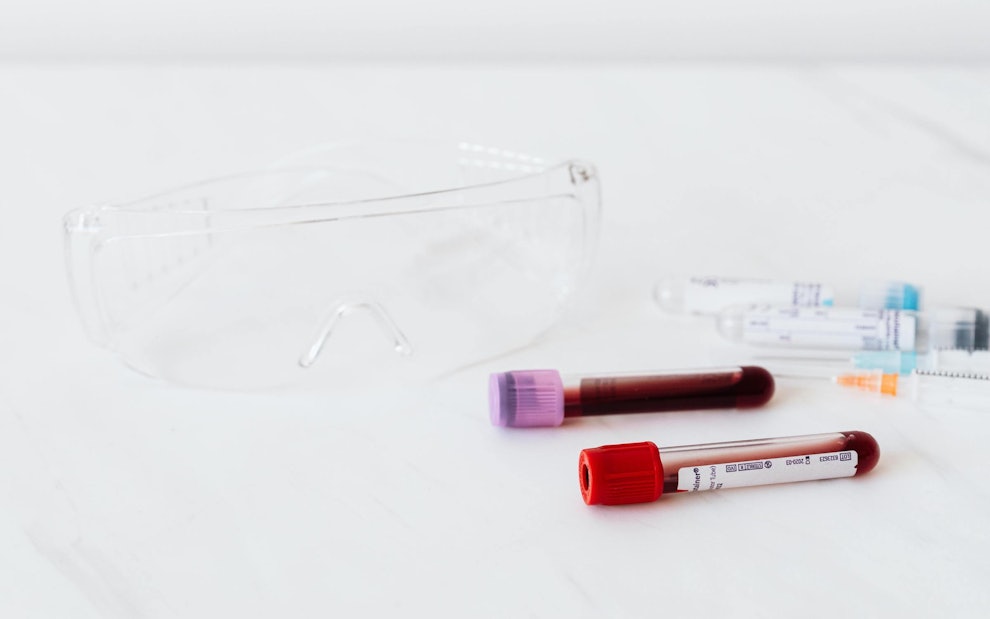Reading Blood Test Results: Tips, Advice, And More
Article at a glance
Blood tests are sometimes ordered as part of routine preventive care or in the event that a patient is experiencing symptoms of a disease that a blood test can help either rule out or diagnose.
There are a variety of blood tests including a complete blood count, a white blood cell count, blood glucose test, and more.
Reading your blood test results can sometimes feel overwhelming or confusing but there are a number of ways to make interpreting the results easier.

Getting blood tests is part of routine preventive care as well as diagnostics. These lab tests can detect potential health problems and give healthcare providers a better idea of a patient’s overall health and wellness.
For patients, reading blood test results can sometimes be overwhelming and confusing. This resource will explain the basics of blood tests including why you might need one, types of lab tests, how to interpret results, and more.

Why You May Need A Blood Test
Your healthcare provider may order blood tests for a number of reasons such as:
- Diagnose or rule out certain health conditions
- Screen for a disease
- Monitor a known illness and its treatment
- Get a better idea of your health as a whole
If you experience symptoms, such as prolonged or chronic fatigue, and other conditions are ruled out, blood tests can help diagnose a condition.
Blood Test Glossary Of Terms
In order to read your blood tests correctly, it’s first important to know the definitions of the terms you’ll be seeing on your lab test results. Some of this terminology can be found below:
Negative or normal results: This means that the disease or substance being tested for is not present in the lab results.
Positive or abnormal results: This means that the disease or substance being tested for is present in the lab report.
Inconclusive or uncertain: This means that the lab report isn’t able to deliver enough data to determine whether or not a disease or substance is present. When this happens, more tests are usually necessary.
Reference ranges: Also known as a normal range or normal values, a reference range is a range of numbers for a marker that is used as a benchmark to determine a lack of disease or good health. For example, normal ranges for blood glucose would be 99 mg/dL or lower. Reference ranges can be dependent on a patient’s age and sex.
MG/DL: This is the unit of measurement used in blood tests. It stands for milligrams per decilitre.

What Impacts Blood Test Results
There are a number of factors that may impact your blood test results such as:
Some food and drinks
Certain medications
Stress levels
Exercise
Lab procedure variations
Being sick
Many blood panels require a patient to fast prior to getting their blood draw. Be sure to speak with your doctor about the proper precautions to take leading up to your test.
Types Of Blood Tests
There are various types of blood tests. For a routine checkup, some of the most common blood tests include:
- Complete Blood Count (CBC)
- Blood Urea Nitrogen (BUN)
- Basic Metabolic Panel
- Comprehensive Metabolic Panel (CMP)
- Lipid Panel
- Thyroid Stimulating Hormone (TSH)
- Vitamin Levels
Within each of these blood tests, there are specific markers, such as cellular blood components, kidney and liver function, or hormone levels to assess thyroid-related health, which a healthcare provider will look at to get a better picture of a patient’s overall health.

Interpreting Complete Blood Count Blood Test Results
This blood test measures the essential components of blood which are red blood cells, white blood cells, and platelets. A CBC measures hemoglobin and plasma levels as well.
Red Blood Cells (RBC) Count
A RBC will count red blood cells in one’s blood sample. Red blood cells are important because they carry oxygen from the lungs to every other cell found in the body. Oxygen is vital for cell growth and cell reproduction. One’s red blood cell count can reveal more about a patient’s health.
A low red blood cell count could be the sign of:
Anemia
Leukemia
Malnutrition
Multiple myeloma
Kidney disease
A high red blood cell count could be the sign of:
Dehydration
Heart disease
Polycythemia
Lung scarring
Lung disease
Kidney cancer
White Blood Cells (WBC) Count
A WBC measures the amount of white blood cells in the blood. White blood cells are a vital part of the immune system and help the body fight off infections and other illnesses. There are five main types of white blood cells. A WBC measures all five types as a whole. For getting specific measurements of each type, a doctor may order a blood differential which is a test that measures the amount of each specific type.
One’s white blood cell count is an important part of diagnostics. A low white blood cell count or a high white blood cell count can indicate a number of health conditions and disorders.
A low white blood cell count could be the sign of:
Immune system disorders (i.e. HIV/AIDS)
Lymphoma (cancer of the bone marrow)
Liver or spleen disease
A high white blood cell count could be the sign of:
Autoimmune or autoinflammatory diseases
Bacterial or viral infections
Cancers such as leukemia and Hodgkin’s disease
Allergic reactions
Hemoglobin
Hemoglobin is a type of protein found in red blood cells that carries oxygen from the lungs to the rest of the body. Abnormal hemoglobin levels could indicate a blood disorder.
Low hemoglobin levels may indicate:
Various types of anemia
Thalassemia
Iron deficiency
Liver disease
Cancer
High hemoglobin levels may indicate:
Lung disease
Heart disease
Polycythemia vera (a disorder that creates too many red blood cells)
Platelets and Mean Platelet Value (MPV)
Platelets, also known as thrombocytes, are small blood cells that are a crucial part of the clotting process; the process that helps the body stop bleeding after an injury.
MPV is a test that measures the average sizes of your platelets. MPV results can be either low or high. Alone, a MPV cannot diagnose any one condition but the results can be read alongside other markers to help make a determination. A normal result for a MPV blood test is 7 fL to 9 fL (femtoliters) for non-pregnant adults.
Interpreting Comprehensive Metabolic Panel Blood Test Results
As the name suggests, a CMP will gather vital information regarding the body’s metabolism and chemical balance. A CMP will measure a variety of markers including electrolytes, bilirubin, albumin, creatinine, and glucose (blood sugar).
Electrolytes
Electrolytes are minerals found in the blood that impact how much water is retained in the body as well as muscle function and blood acidity. Some common electrolytes include calcium, chloride, magnesium, phosphorus, potassium, and sodium. A CMP will measure each of these in order to determine the fluid and electrolyte balance in the body.
Bilirubin
Bilirubin is a yellow-tinted substance that is created during the bodily process of breaking down red blood cells. Bilirubin can be found in bile, a fluid produced by the liver that aids in food digestion.
High levels of bilirubin found in a laboratory test can indicate liver disease or that the liver is not working in the way that it should be.
A really important part of the CMP is Creatinine and BUN which measure the function of the kidney. A high Creatinine or BUN means that the kidneys are not working well.
Interpreting Lipid Panel Blood Test Results
A lipid panel measures fat molecules (lipids) in the blood. A lipid panel usually reads one’s cholesterol and triglyceride levels.
Cholesterol
Cholesterol is a substance that is produced in the liver that is involved in a variety of processes. There are a few main types of cholesterol:
- High-density lipoprotein (HDL): This is considered to be “good” cholesterol because it carries cholesterol from various parts of the body back to the liver. The liver then proceeds to remove that cholesterol from the body.
- Low-density lipoprotein (LDL): LDL is considered to be “bad” cholesterol because high levels of LDL can lead to a buildup of plaque in the arteries which can lead to a host of other health problems.
- Very low-density lipoprotein (VLDL): This is considered to be “bad” cholesterol. It is important to note that VLDL is different from LDL. VLDL carries triglycerides while LDL carries cholesterol.
Note: Learn more about recommended health screenings at this resource.
Triglycerides
Triglycerides are a type of fat and are the most common fat in the body. Triglycerides are derived from food sources such as butter and oils. Eating excess calories results in the creation of triglycerides which the body then stores in its fat cells and saves for later release when the body needs energy. The VLDL particles carry these triglycerides to your tissues.
High triglyceride levels can raise your risk of heart disease which is why monitoring your levels is important.
Glucose
Glucose, also known as blood sugar, is the main sugar found in the blood. Derived from the food one consumes, glucose is the body’s main source of energy. A blood glucose test measures the amount of glucose in the blood. Blood glucose tests usually require you to fast for a certain amount of time prior to testing.
High blood glucose may be the sign of:
- Pre-diabetes or diabetes
- Hyperthyroidism
- Pancreatic disorders
- Stress as the result of surgery, injury, etc.
Low blood glucose may be the sign of:
- Diabetes
- Liver disease
- Kidney disease
- Hypothyroidism
- Alcohol use disorder (AUD)
Note: To see how your test results compare to normal, you will check the reference range on your lab report. You cannot compare your testing results to averages you find online or from different labs, as each lab may use different testing methods.
Tips on Preparing for a Blood Test
Preparing for your blood test and knowing what to expect will make the whole process that much smoother.
Stay Hydrated
Staying hydrated before getting a blood test is important to not only avoid dehydration but to plump up the veins and make them fuller and therefore easier to draw blood from.
Confirm Details
Talk to your provider to confirm whether or not fasting is necessary as well as what you can drink before your testing. As well, discuss any medications you are taking as well as allergies.
Note: To learn more about preparing for a blood test, check out this resource.
Always discuss your blood test with a healthcare provider. He or she will be able to help you interpret the results and make sure you know which values need action and which are normal for your state of health or age.
Why are getting blood tests important?
Blood tests are a part of routine preventive care. Blood tests can also help diagnose certain health conditions that need treatment.
What do I do if I receive abnormal blood test results?
If you receive abnormal test results, your doctor will contact you to discuss your course of action.
How often should I get my blood tested?
At least once annually during your physical exam. However, those with pre-existing conditions such as hypertension, heart disease, etc., may need more routine blood work. Talk to your healthcare provider about your specific situation.
Why would I ever need a repeat blood test?
Sometimes, a blood test may deliver inconclusive results. This means that the blood sample was not sufficient in providing the information necessary. As well, borderline results (i.e. the number given by the sample was right in between a positive or negative result) may require additional testing to confirm the results.
Become a patient
Experience the Oak Street Health difference, and see what it’s like to be treated by a care team who are experts at caring for older adults.




